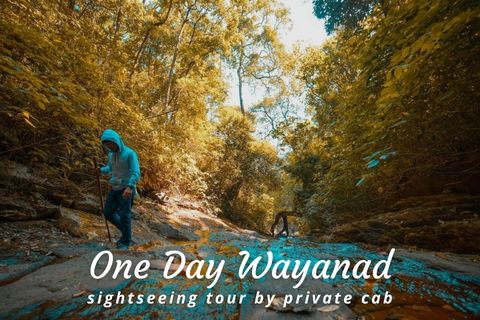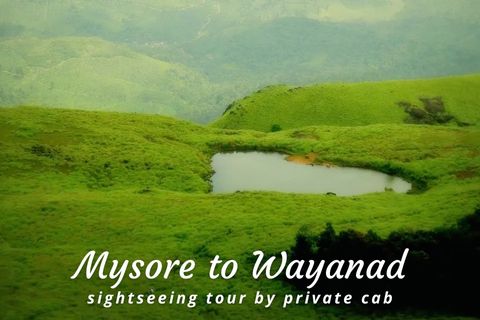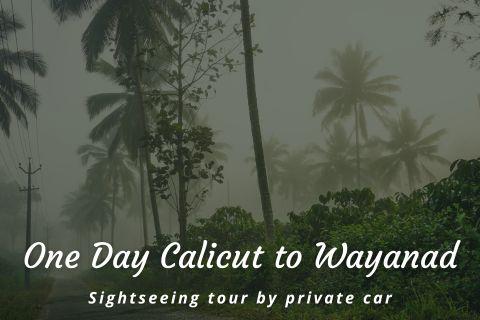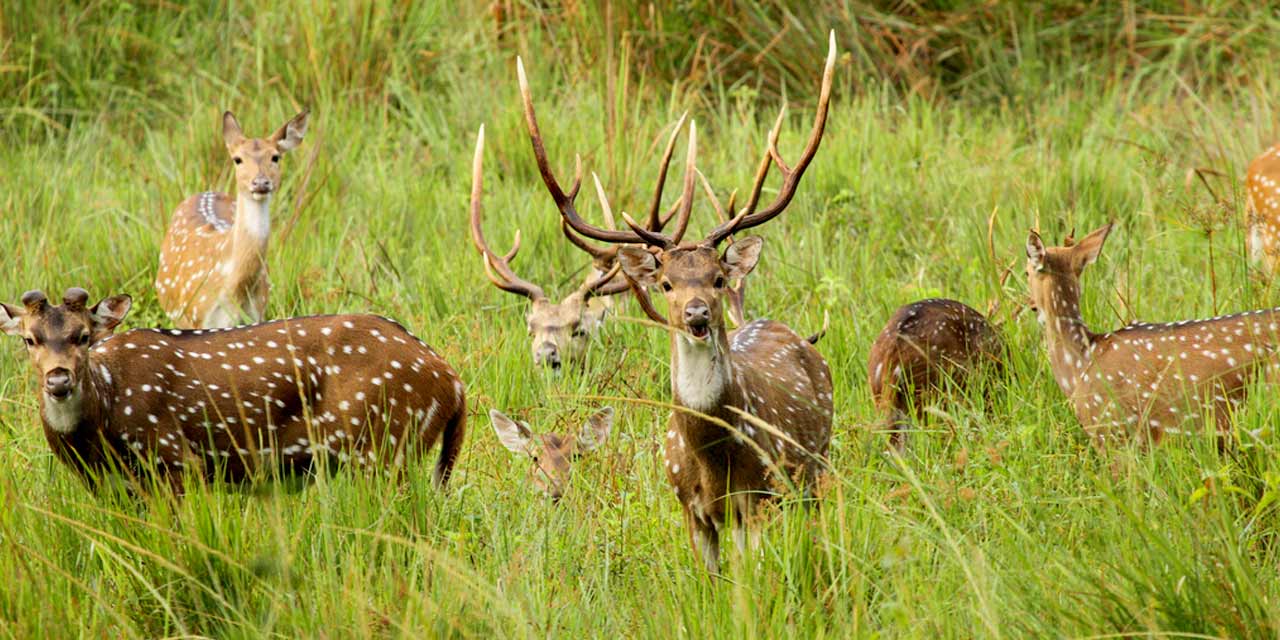Wayanad Wildlife Sanctuary Entry Fee
- 20 per person for Indian Adults
- 10 per person for Children below 12 years and bonafide students
- 110 per person for Foreign Tourists
- 25 for Still Camera
- 150 for Video Camera
- 50 Parking fee for Light Vehicle
- 150 Parking fee for Heavy Vehicle
- 100 Guide fee
- 300 for Jeep Safari
Wayanad Wildlife Sanctuary Phone
09188 407547
085476 03486
Rating:  | 4/5 stars
| 4/5 stars
Based on total 21 reviews
Wayanad Wildlife Sanctuary Address: Bathery- Puthupally Road, Sultan Bathery, Panavally, Kerala, 673592, India
Wayanad Tour Packages
Wayanad Wildlife Sanctuary Timings
| Day | Timing |
|---|---|
| Monday | 7:00 am – 10:00 am 3:00 pm – 5:00 pm |
| Tuesday | 7:00 am – 10:00 am 3:00 pm – 5:00 pm |
| Wednesday | 7:00 am – 10:00 am 3:00 pm – 5:00 pm |
| Thursday | 7:00 am – 10:00 am 3:00 pm – 5:00 pm |
| Friday | 7:00 am – 10:00 am 3:00 pm – 5:00 pm |
| Saturday | 7:00 am – 10:00 am 3:00 pm – 5:00 pm |
| Sunday | 7:00 am – 10:00 am 3:00 pm – 5:00 pm |
The Wayanad Wildlife Sanctuary has four ranges, of which Muthanga is one. Mainly a rainforest, Muthanga Wildlife Sanctuary is one of the most bio-rich areas in peninsular India. This eco-tourism centre is home to both moist and dry deciduous trees and semi evergreen forests.
Part of the Nilgiri Bioreserve, Muthanga Wildlife Sanctuary shares a significant portion of the Western Ghats and its densely forested Malabar Hills. Known for its elephant population, this range of the Wayanad Wildlife Sanctuary offers sightings of a number of other wild animals too.
However, sightings heavily depend on luck, and one cannot be guaranteed to have a successful spotting on the first safari itself. For this reason, most wildlife enthusiasts prefer to stay around the sanctuary for a few days and try their luck on safaris every morning and afternoon.
Muthanga Wildlife Sanctuary Timings & Entry Fee
The Muthanga range of the Wayanad Wildlife Sanctuary is one of the few in the country which are allowed to be open throughout the year. Different seasons bring out different aspects of the wildlife sanctuary. If sightings are your main concern, visit here in the summers. From April to June, the forests experience scorching heat, and this brings out most of the wild animals to water bodies in the plain view of onlookers who sit inside their safari jeeps with bated breath.
On the downside, this heat becomes almost unbearable for some, making it an arduous task to endure the jeep safaris, especially in the afternoon slots. Forest fires are also known to occur in the forests during the summers.
Monsoon (July to September) is another avoidable time when Muthanga Wildlife Sanctuary is slushy and the visibility is quite low, making it both uncomfortable and pointless to be out on the search of wild animals.
The winter and spring months of October through March are a nice time to enjoy the forest. Sightings may not be so good, but birdwatchers will still have a ball watching indigenous and migratory birds fill the woods. The pleasant weather also brings with it gorgeous flowers and lush foliage.
In each season, the sanctuary is open to walking visitors from 7 AM to 5 PM. However, if you opt for a safari, you will be able to visit only between 7 AM and 10 AM and again between 3 PM and 4:30 PM.
The fee is INR 20 for Indian adults, INR 10 for children under the age of 12 and students who carry a proof with them. Foreigners are charged INR 110 per head. If you are planning to take your camera along, the charges are INR 25 for still camera and INR 150 for video camera.
If you are driving down to Muthanga, you will be able to park your vehicle at a cost of INR 50. Buses and other heavy vehicles are charged INR 150. It is advisable to take a guide with you as they know the routes well and have a sharp eye for sightings and can also assess bird and animal calls. Guides cost INR 100.
The most popular mode of exploring the Wayanad Wildlife Sanctuary is by taking the jeep safari. This comes at a cost of INR 300. The jeeps here are not roofless as in other national parks, though. The total time permitted inside the wildlife sanctuary is only 2 hours.
History Behind the Muthanga Wildlife Sanctuary
Wayanad Wildlife Sanctuary was formally accorded the status of a wildlife sanctuary in the year 1973. Almost a couple of decades later, in 1991 and 1992, Muthanga was made a part of Project Elephant, in an effort to conserve India’s Asian elephants in their natural habitat.
Layout of Muthanga Wildlife Sanctuary
Located at the border of the neighbouring states of Karnataka and Tamil Nadu, the Wayanad Wildlife Sanctuary in Kerala is connected to the Nagarhole National Park and Bandipur National Park to the north east in Karnataka and Mudumalai National Park to the south east in Tamil Nadu. Collectively, these national parks and wildlife sanctuaries spread across three states form a tropical rainforest corridor.
Wayanad Wildlife Sanctuary is divided into two sections, North Wayanad Wildlife Sanctuary and South Wayanad Wildlife Sanctuary. While the region between these two parts was once a forest, commercial efforts ensured that the woods were cleared for tea plantations, making the sections separate and unconnected.
The sanctuary covers a total area of 345 square kilometres, and Muthanga comes under its southern section. Part of the Deccan Plateau, Wayanad Wildlife Sanctuary is subdivided into 4 ranges according to the mountain ranges, Tholpetty, Kurichiat, Sulthan Bathery and Muthanga.
Things to do at Muthanga Wildlife Sanctuary
Wayanad Wildlife Sanctuary has enough activities to keep you soaked in its beauty for a few days. We list some of the interesting things you can do here:
1. With a special permission from the Wildlife Warden or Muthanga Wildlife Sanctuary, you can arrange for an elephant ride. While you go about the forest, apart from these Asian pachyderms which freely move about the area, you can also see a lot of butterflies and other insects.
2. Go on a birding tour with professional birders and a naturalist who can help you sight beautiful avifauna that call this wildlife sanctuary their home. It is advisable to carry a pair of binoculars, a notebook and pen to keep a note of all your sightings and the names of every bird, and a zoom-lens camera which can capture your finds with clarity. Most birders also recommend carrying a monopod with you for better stability and luck with catching birds in flight.
3. Muthanga Wildlife Sanctuary operates a special elephant camp which is a training centre for baby elephants to be tamed before they turn wild. These trained elephants are called Kumki. It is possible to attend an elephant training camp to see how this works. You can watch the mahouts teach their elephants how to obey commands, work with timber and even convince wild elephants not to go astray or attack humans when they enter into human territory while losing their way.
4. For the physically fit, a walking tour inside the wildlife sanctuary is an excellent idea. However, you will need to ensure your attire is comfortable enough for you to be able to cover approximately 12 km of distance inside on foot. You can carry a reusable water bottle to manage your thirst as there are no cafes or water stations inside.
5. The most common way to explore the outer zone of the Muthanga Wildlife Sanctuary is to go on a jeep safari. These jeeps come with a ranger or a forest guide who are well versed with the topography of the area. If you are travelling in a group, the jeep safari is quite convenient as you don’t have to walk all by yourself and you can also make multiple rounds of the forest in search of the elusive tigers and other wild fauna. Unfortunately, the jeeps at this sanctuary are not roofless like in other parts of India. So, your view is limited. Grab a window seat to make the most of your safari experience which operates only in the mornings from 7 AM to 10 AM and in the afternoon from 3 PM to 4:30 PM.
Image Gallery of Wayanad Wildlife Sanctuary
Interesting Facts About Muthanga Wildlife Sanctuary
If you still cannot find enough motivation to visit Wayanad Wildlife Sanctuary, here is some trivia to make you want to pack your bags and see this animal sanctuary soon:
1. Muthanga Wildlife Sanctuary is the second largest animal sanctuary in the state of Kerala.
2. The local tribals live not only around the forested area but also inside the sanctuary. The Forest Department of Kerala aims to maintain a balance between protecting the tribal community and preserving the wild animals.
3. This biodiversity hotspot was once the battleground for Pazhassi Raja who fought against the British colonialists and the East India Company in 1805, giving a fillip to India’s freedom struggle.
4. The forests that make Muthanga Wildlife Sanctuary include different types, ranging from West coast semi-evergreen forests to South Indian Moist Deciduous forests, including trees such as Grewelia, eucalyptus and teak. The moist deciduous forests typically have trees and herbs such as maruthi, bamboos, karimaruthi, mazhukanjiram, rosewood, chadachi, venteak and vengal. The semi-evergreen forests have their own lustrous plants like veteria indica, termianalia paniculata, lagerstroemia and lanceolata.
5. Muthanga Wildlife Sanctuary has 45 species of mammals, including barking deer, tiger, common otter, spotted deer, gaur, leopard, bonnet macaque, sambhar, panther, Nilgiri langur, jungle cat, sloth bear, civet cat, wild boar, bison, monkey, wild dog, Malabar giant squirrel, common langur and more.
6. Birdwatchers can look forward to sighting 203 species of birds which are found in the sanctuary, including the Malabar Grey Hornbill, peafowl, herons, wagtails, jungle fowl, egrets, babblers, roller, shrikes, woodpeckers, pheasants, cuckoos, snipes, owls, water ducks, etc.
7. When it comes to reptiles, this wildlife sanctuary has about 45 species of these, some of which are Common Sand Boa, Collared Cat Snake, Brown Vine Snake, Ceylon Cat Snake and Beaked Worm Snake, apart from various lizards, including the monitor lizard.
8. When it comes to fish, there are 59 species in Wayanad Wildlife Sanctuary, including some dangerous ones such as the poisonous African catfish.
9. 30 species of amphibians can be spotted in these forests. You can keep your eyes peeled for Golden-backed frog, Indian Pond Frog, VUB Night Frog, Kerala Warty Frog, Nilphamarai Narrow-mouthed Frog, Malabar Torrent Toad, Wayanad Torrent Frog and Minervarya Frog.
10. Muthanga Wildlife Sanctuary is home to the threatened species of vultures such as the Red-headed Vultures and the White-rumped Vultures. Vulture count has been dropping sharply in the forest, including the number of vulture nests. The fall is attributed to a banned drug which is still used in this region. Plan your visit soon before you run out of the chance to see these threatened vultures.
11. Tribes living in these forests include some scheduled adivasis such as Paniyas, Kattunaikkans, Kurumas, Ooralis, Adiyans and Kurichiyas.
12. Wayanad Wildlife Sanctuary has the largest population of tigers in all of Kerala and even the country. A whopping 75 tigers reside in these dense forests, while the rest of the state has the remaining 101 of the total tiger count of 176.
13. The addictive scent of eucalyptus fills the air inside the forest, thanks to the abundance of eucalyptus plants here. Apart from this therapeutic plant, one will also be able to smell coffee as the beverage plantations are almost everywhere in Kerala.
14. 17 anti-poaching stations are installed inside the Muthanga Wildlife Sanctuary to prevent any miscreant from hunting in the wild, whether for leisure or game meat or other industrial purposes.
15. No matter the biosphere tourist activity you choose to explore the forest, you will be restrained to the outer zone of the sanctuary. The inner zone, which has a richer concentration of flora and fauna, is only open to the forest officials and wildlife researchers.
Things to Keep in Mind While Visiting Muthanga Wildlife Sanctuary
Forest reserves, national parks and wildlife sanctuaries require special attention and caution on the part of visitors. For a pleasant experience for both you and the animals, here are some pointers to follow while you explore Wayanad Wildlife Sanctuary:
1. You will need a permit from forest authorities before you can enter the main gate of the Muthanga Range of the Wayanad Sanctuary.
2. To avoid alarming the birds and animals, dress to camouflage. Wear dark and dull shades of clothing and colours that don’t easily stand out such as savage green, brown, off white, etc. Avoid wearing bright tints of red, orange, yellow or fluorescent hues.
3. Afternoon safaris can be unbearably hot, so it is best to drape a scarf and wear a hat or a safari cap that covers the nape of your neck and saves you from getting sunburnt. Do not forget to apply generous amounts of sun block, especially SPF 40 or higher.
4. Since the animals are either attracted or irritated by strong smell, avoid wearing perfumes with sharp notes or even applying moisturizers or other skin and hair products with sweet scents. You can stick to a basic deodorant with musk or citrus notes if you are worried about perspiring too much in the heat.
5. If travelling with children, educate them in advance not to speak loudly or scream at the sight of any animal or bird. Sightings become more difficult if the animals become agitated. Besides, the constant noise of humans also stresses out the wild animals. Even birdwatching becomes a task if there is no silence, as birds are generally not patient.
6. Carry different sets of cameras to get the best snaps from your jeep safaris. A versatile point-and-shoot is good for those who are not adept with DSLRs. Otherwise, a sturdy camera with a zoom lens and a monopod is ideal for a successful ride.
7. You might want to apply mosquito repellent sprays or creams on the exposed body parts before you enter the forest as insects are not avoidable in the wild.
8. Pets are not allowed inside the wildlife sanctuary. Hence, it is better for you to keep yours with a caretaker at your resort.
9. The arduous task of covering 12 km in 2 hours can seem a bit daunting if you are on the walking trail inside Muthanga, so wear your trusty all-terrain shoes and carry plenty of water with you. Keep in mind that the forest is a plastic-free zone. Hence, plastic boxes or bottles will not be allowed. Metal flasks are recommended for your hydration requirements.
Places to Visit Near Muthanga Wildlife Sanctuary
The Muthanga Range of the Wayanad Wildlife Sanctuary may be a bit farther from the more popular ranges of the second largest wildlife sanctuary in the state of Kerala, but there are a handful of places you can visit once you are done exploring this to your heart’s content:
1. Seetha Devi Temple: Only 3.5 km from Muthanga Wildlife Sanctuary, this Hindu temple in the Pulpally region of Wayanad is dedicated to the deity of Seetha from the Ramayana epic. The temple is the only one in all of India to have the deities of the twin sons of Rama and Seetha, Lava and Kusha. Seetha Devi Temple has a pond in its premises which happens to be the largest in the district of Wayanad. Pulpally itself is also venerated as the place where Seetha found shelter in the cottage of the Hindu sage Valmiki after she was abandoned by her husband.
2. Kuruva Island: Also known as Kuruvadweep, this protected river delta is an island which does not have any permanent residents. Surrounded by a group of satellite islands, Kuruva Island is the only one in this group that manages to stay afloat while the others often submerge in the rainy season. Spread over 950 acres, Kuruvadweep sits on the banks of the tributaries which form the mighty Kabini River. The island is quite rich in biodiversity, thanks to its avifauna, herbs and orchids. The only way to reach this secluded wonderland is to take the rafts or fibre boats which are operated by the state tourism department.
3. Valmeekam Tribal Museum: At a distance of 51 km from Wayanad Wildlife Sanctuary, this museum is dedicated to tribal art. The entry fee to Valmeekam Tribal Museum is only INR 30 per head and it is open from 9 AM to 6 PM on all days of the week. The collections include paintings and sculptures by tribal folk, and the museum is managed privately. The adjacent museum shop also sells some of the tribal paintings at prices ranging from INR 2,000 to INR 15,000.
4. Begur Reserve Forest: A 2-hour drive from Muthanga will bring you to the Begur Reserve Forest in Kalpetta. Located on the Western Ghats, Begur is covered with the West Coast semi evergreen forests and deciduous trees that give it a lush green appearance. Wildlife fans can look forward to sightings of bison, elephants, civets, bears, panthers, spotted deer, monkeys, wild boars, jungle cats, wild dogs and more. Even the rare tiger can be spotted at Begur which is home to plenty of it. Birding enthusiasts will be able to find kingfishers, woodpeckers, bulbuls, thrushes, mynas and peafowl among many other birds.
5. Thrissilery Shiva Temple: Located approximately 60 km away from Wayanad Wildlife Sanctuary, this Hindu temple is on the Mananthavady-Mysore Highway. The deity of Shiva is venerated at this shrine which also has a temple tank which is perennially full of water. If you are going to be here around March and April, do not miss the annual festival which follows the month of Meenam from the Malayalam calendar. The winter month of Thulam which falls roughly between October and November, sees the celebration of another festival called Puthari. Thrissilery Shiva Temple is open on all days from 6:30 AM to 10 AM and again from 5 PM to 6:30 PM.
6. Muneeswaran Kunnu Viewpoint: A couple of hours from the wildlife sanctuary is this trekkers’ favourite. You can take your car till the entrance where a fee of INR 40 is charged per head. Since hiking and camping are encouraged here over touristy sightseeing, Muneeswaran Kunnu Viewpoint is best visited on foot (after you have parked your vehicle at the entrance). There is a limit to how many can stay on top, so you will have to check with the locals if you wish to pitch your tent there. The view from the hilltop is mesmerizing, especially on a clear day.
7. Muneeswaran Temple: 45 kilometres away, this Hindu temple in Thalapuzzha is a pit stop to the Muneeswaran Kunnu Viewpoint which takes two more hill crossings to reach. If you are hiking, it is advisable to begin early in the morning so that you can return before the sweltering heat of the sun starts to make you uncomfortable. The other option of hiking in the evening is recommended only for those who are very fit and can hike speedily, as you will need to return to the base before sunset. This temple is old and uninteresting but the views more than make up for this.
8. Thirunelli Temple: Located by the Brahmagiri Hill, this famous temple sits at an altitude of 900 metres above sea level. With forests and mountains guarding it on all sides, Thirunelli Temple enjoys its position as a Hindu pilgrimage site. The name of the temple offers special mention to gooseberries as ‘nelli’ means ‘gooseberry’ in Malayalam and Tamil. There is a river and a spring at a distance of a kilometre from this temple, both of which are known as ‘Papanasini’ which translates to ‘the washing away of sins’. Devotees often bathe in this river in the hope that their sins will be cleansed.
9. Irupu Falls: On the highway to Nagarhole, the Irupu or Iruppu Falls are a lovely set of cascading waterfalls in the Brahmagiri Range of mountains. Also known as Lakshmana Tirtha Falls, the fresh water from these falls are a source of supply to a tributary named Lakshmana Tirtha River that contributes to the famous Cauvery River. Many Hindu devotees believe that their sins will be washed off if they bathe in the Iruppu Falls. Hence, it is common to find people bathing in these waterfalls, especially on the religious day of Shivatratri, which is a Hindu festival.
How to Reach Muthanga Wildlife Sanctuary
Muthanga Wildlife Sanctuary is a safe haven for Kerala’s wild animals. Understandably, it is quite far from modern civilization. To get to the interiors of Wayanad where this wildlife sanctuary is located, one has to travel quite a bit. Depending on your preferred mode of transport, the distance you need to span and the time and budget you have on hand, you can pick from the following ways to arrive here:
By Air: Kozhikode International Airport is the nearest civil airport to Muthanga. Also known by its former name, Calicut International Airport services not only most major Indian cities but also several foreign nations in the Middle East, the Indian Subcontinent and South East Asia. From the airport, the wildlife sanctuary is about 125 km away, and a cab will take almost 3 hours and 30 minutes to scale that distance.
By Train: To better enjoy Kerala’s scenes from your window, you can opt for a train ride. The rail head closest to Wayanad Wildlife Sanctuary is Kozhikode Railway Station at 112 km. You will easily find a cab to take you to your final destination which is 3 to 4 hours from there. Train bookings in India begin 30 days to 4 months in advance. Depending on the demand for the route, tickets may get quickly filled up, so it is advisable to book early.
By Bus: While overnight bus rides can be a bit tiring, they happen to be fairly affordable, especially for solo budget travellers. The main bus stop near Muthanga Wildlife Sanctuary is Sulthan Bathery, at a distance of 14 km. You will easily get a cab for hire from here. Bus tickets are usually very easy to get, even at the 11th hour. So, there is no need to book in advance or worry if you have any last minute plans.
By Car: The most hassle-free way to travel to Wayanad Wildlife Sanctuary is in a comfortable air-conditioned car. You can book yours from top car rental companies in Wayanad in advance to avoid having to haggle to local taxi drivers once you have already reached Wayanad. Since the wildlife sanctuary is in the interiors where the roads may not always be smooth, it is best to hire an SUV with good ground clearance for your convenience.
Nature lovers can never get enough of Wayanad and to explore it to the fullest book a Wayanad tour package with us. We at Wayanad Tourism, a division of Holidays DNA make sure you have a great holiday experience while exploring the popular sightseeing places of Wayanad. So, what are you waiting for? Please fill the Contact Us form and get ready for a memorable holiday experience.





